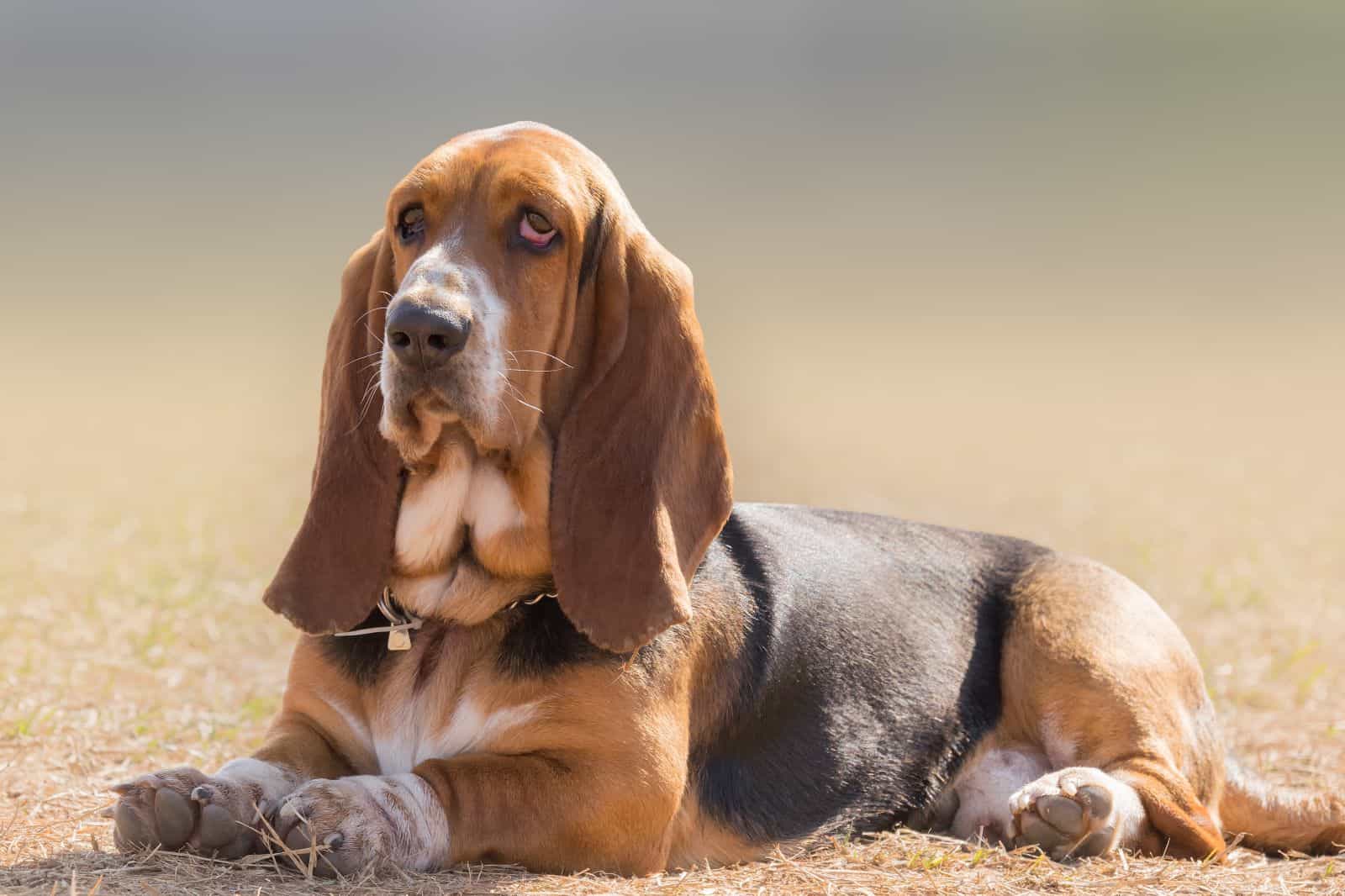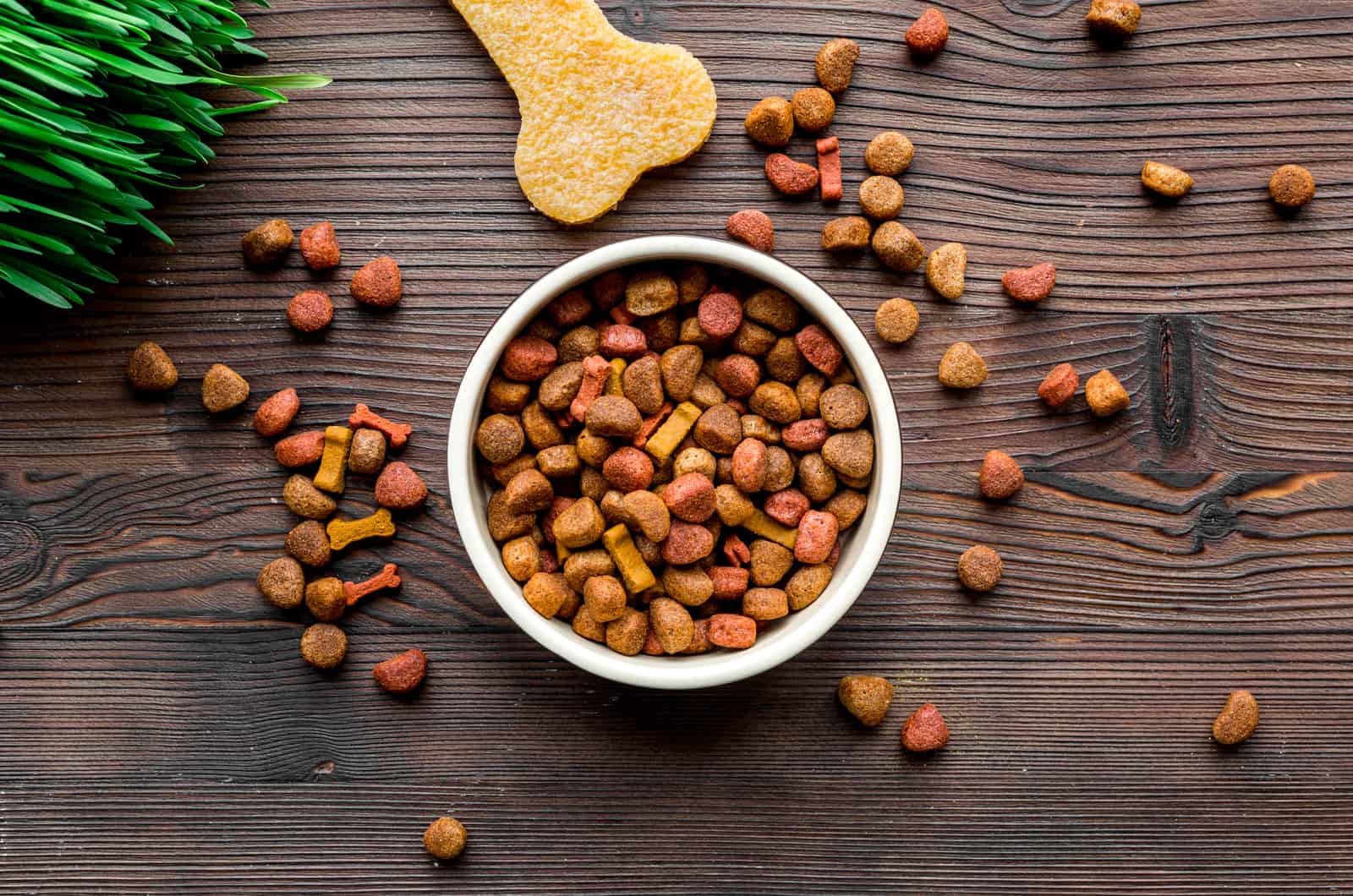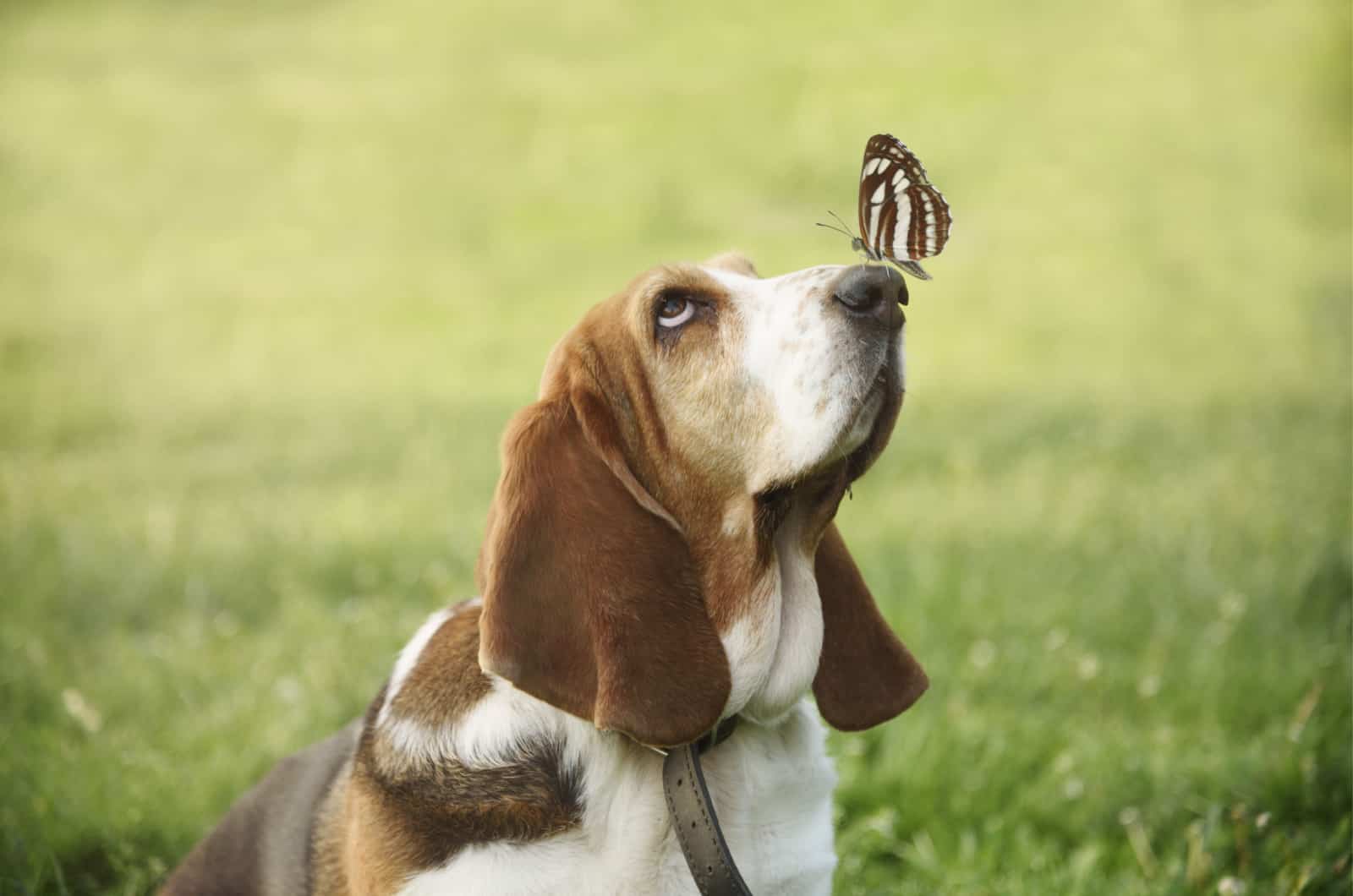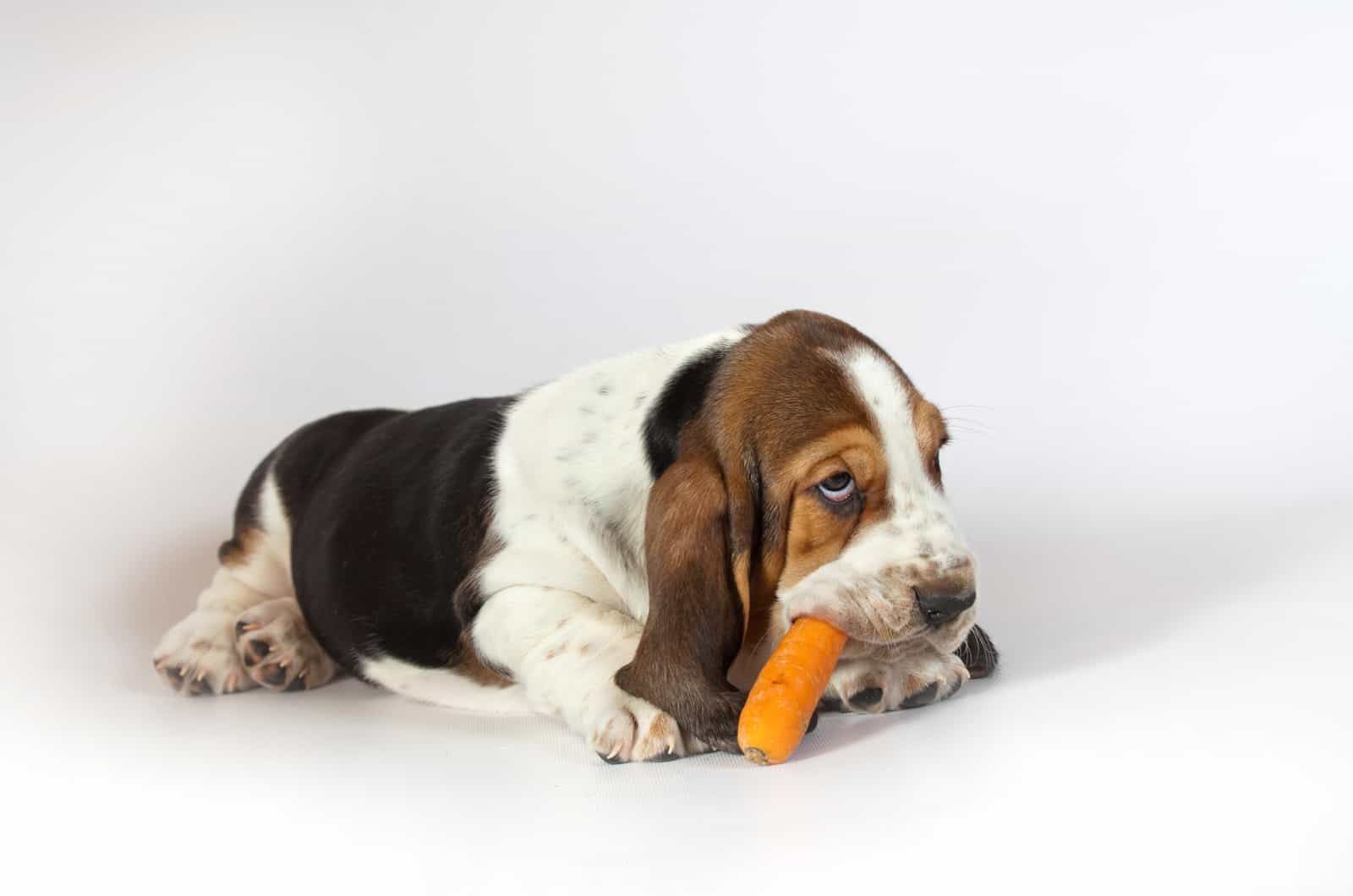It has been a long time since the Frenchman who developed this breed called it Jolie. What hides behind this Jolie word has a very interesting meaning – it is a word for pretty ugly.
Even though this term sounds pretty ugly, it is actually a compliment, and it means something that is beautiful and eye-catching, but in some unconventional way.
And, we can agree that our “bas” pooch is unconventional, and that makes him so appealing… so appealing that you get the desire to find out more about him.
So, why don’t you make a Basset Hound feeding chart so that you will learn better about this descendant of a Bloodhound.
It is time to dive into our topic.
Basset Hound Feeding Chart Explained

Even though I am really into dogs and everything dog connected, there are still many things I need to learn. One of them is a Basset Hound feeding chart, but it is not the only thing I am unaware of when it comes to this French breed.
First thing I was wrong about was the size of the Basset Hound. I must have seen the miniature Basset Hound somewhere and made a conclusion that it is his standard size.
But, this tricolored (Basset) Hound is actually a large but very short dog breed, and an adult dog is as heavy as a schoolchild.
Maybe that is why the Basset Hound feeding chart won’t surprise you.
But, let’s take a look. We will start with puppyhood, and the nutrition needs during this most important developmental phase.
Basset Hound Feeding Chart
[table id=522 /]
Think of yourself in different points of your life. When you were a small child, you didn’t need as much food as you needed later when you were about to become an adult.
The same is with dogs – the bigger the dog, the more amount of food he needs, and vice versa. But, it is much clearer when you see the table… check it out!
Basset Hound Puppy Feeding Chart
The right decisions at the right time gives us optimal results. In order to develop as he should, your dog has to have enough sleep (get your Basset the right bed), enough play, and the right amount of correct dog food that is good for Basset Hounds.
During puppyhood, a Basset can reach 20 pounds. It is clear in the chart that when he reaches his maximal puppy weight, this dog needs a maximal one-and-a-half cups of puppy food.
When he is so small that he weighs only four pounds, you should serve him only a third of a cup of the best dog food.
It is easier for him to chew wet food, but if you decide to go with dry dog food, you can learn how to soften dog food or make puppy mush.
You will notice from the chart how progressively more food a dog needs as he gains weight. So, make sure that his kibble is filled with some fine delis.
This doesn’t mean that weight gain should be endless. The column in the chart presents healthy weight, and everything that is not optimal might be an alarm for the possibility of developing obesity.
And, Bassets are very prone to that problem, but we will talk more on that later. Now, let’s move to the next phase – adulthood.
Adult Basset Hound Feeding Chart
Believe it or not, and I was surprised, too (it seems like there are many things that surprise me about this dog), this short pooch’s puppyhood isn’t short at all.
Did you know that when it comes to the schedule of the Basset Hound’s lifespan, things are a bit different?
Since he is so active and agile in puppyhood, Mother Nature awarded this dog with a prolonged period of children’s joys.
He reaches his adult age only within two years. That is approximately the time when he has reached his greatest possible healthy weight or at least 90 percent of it.
But, there is a catch. As he gets bigger, his activity level gets smaller, and if you dont follow the Basset Hound feeding chart, you will get yourself one obese hound dog.
So, here is the deal – a fine adult weight is 40 pounds at the beginning of adulthood, and it is OK to give your dog two cups of food in a day.
When your dog reaches 60 pounds, then it is time to upgrade the quantity and serve three-and-a-half cups of high-quality adult dog food in one day.
Feeding guidelines tell us that if our dog is 80 pounds, then he needs four cups of food a day in the phase of life while he is still physically active.
It is best to get a good Basset Hound harness to keep him at bay because this dog doesn’t know about self-control when there is something yummy nearby.
Senior Basset Hound Feeding Chart
Once you reach the senior years, many problems occur. This is the same with dogs, especially if they are one of the large breed dogs.
In the dog world, in many cases, changes have already occured by the time he is one year old.
But, when the dog is seven years old, for example, we are talking about some serious changes. Changes can start with the type of food your dog consumes, when dry kibble is switched with wet food, or the overall health that has changed.
In this period of life, you can see the effects of the eating habits that were adopted on a regular basis in the earlier phases of their life.
You find yourself more often in the situation where you ask, What do I feed a sick dog with no appetite? But, we will talk about that on some other occasion.
Now, we want to know how to feed a senior Basset Hound.
Because of the possible health issues and slower metabolism, mealtimes should be served more often in senior years.
Most Basset Hounds in this period of life weigh around 65 pounds, which means they should be served three-and-a-half cups of food.
But, the whole amount of food intended for the whole day should be dispersed in two or three meals – preferably in the morning, noon, and afternoon.
What Is The Best Food To Feed A Basset Hound?

In the minds of many pet owners, the question of what the best food to feed a Basset Hound is boils down to the battle between dry and wet dog food.
You may spend days and days reading food labels, and still you won’t be sure which one to pick.
I admit it is a hard task, especially when it comes to decisions about your dog’s life. But, try to relax now… give your Basset Hound a toy to keep him occupied while you read the rest of this text.
I have gathered some knowledge from books and from the experience of other owners that could help you resolve your feeding dilemma. Let’s see what it is all about here.
Dry Vs. Wet Food For Basset Hounds
You will hear owners talking about how they only feed their pups dry food. Others will swear that only wet food is the right choice. Some others combine both, and it seems that there is no end to this topic.
But, if you think about it, it is like you are deciding if the European Basset Hound is better than the American version. It is not a simple question and there is no simple answer to it.
But, we can compare positive and less positive sides of both variations. So, let’s do some work.
Pros And Cons Of Dry Food
Dry kibble is the favorite choice for many breeders and dog owners, and we will see why.
Pros
It is better for the health of the teeth. Seriously… since it is rougher and demands a lot of chewing, it is beneficial in teeth cleaning.
It doesn’t stick to the teeth, and it even helps remove dental plaque.
Another benefit is that dry food won’t easily go bad. It can stay in the kibble the whole day and nothing will happen.
All you need to think of is how to keep ants away from the kibble.
The next best thing is that you only need a small amount to fulfill your dog’s nutritive needs because it is high in protein, and cleaner compared to the wet.
Cons
The main cons are starchy carbs that some dry dog food contain. You should always aim for grain-free food (there are many options in pet stores and on Amazon).
These ingredients are not completely digestible, and they are not well-suited for a dog’s stomach. But, even if you think that you have avoided them, there is always a possibility that they are there.
Pros And Cons Of Wet Food
Wet food is not that popular as dry, but it has its own positive and less positive impact.
Pros
Wet food is made so that it has 75% of water in its composition. This is beneficial for two reasons.
First, it is soft and a dog can easily chew it and swallow it.
This feature is most important in the early days of your Basset puppy if you are switching to puppy food from mother’s milk.
Small dogs are still teething, and they can easily eat soft food rather than dry.
It is also more suitable for older dogs because they can also have problems with swallowing due to some other factors.
Another benefit is that since it has 75% of water, it can protect your dog from dehydration.
This is especially important for older dogs that are not willing to drink so much anymore.
Cons
One disadvantage of wet food is that it sticks to the teeth, and you have to put in some extra effort to clean them regularly.
Another disadvantage is a bit more serious. There is some research that found that canned food causes some damage to a dog’s body.
It contains Bisphenol A – a matter that is found in metal that causes such a negative impact, which causes health problems.
The Combination Of Dry And Wet Dog Food For Basset Hounds
Well, since there are pros and cons for both, one might think of a possible solution by combining both in a balanced diet plan.
And, yes… it is possible, but under a condition.
The first thing you shouldn’t do is mix it together. And, by that, I mean mix them at the same time in the kibble.
If you want to make a combination, then feed them separately. Serve one in the morning, and the other in the afternoon.
But, you should also make sure that your daily calorie requirements are in accordance with the recommended measures.
Also, if your dog is having some stomach problems, then it is better not to mix these foods.
But, all in all… both of these options have optimal nutritive value, so whatever you choose, just make sure it is high quality.
Can My Basset Hound Eat Raw Food?
The short answer to this question is YES!
I have been talking to some Basset Hound owners who have tried this approach, and they say that they had some good results.
They state that it is not so much the raw food, but homemade dog food that makes the difference. It can be cooked as well, and the results will be great.
Preparing food at home might be a little bit challenging (and one might even be tempted to feed their dog human food, but you should be careful here).
All in all… it is worth a try – just make sure how much raw food to feed a puppy and an adult dog.
If you want to try cooking, then you can learn how to boil chicken for dogs, and why hamburgers and rice for dogs are good options.
But, there is so much more to this topic. If you are willing to investigate this way of feeding your dog, it definitely has a green light. It would be a big plus to your Basset Hound feeding chart.
What Should Be The Ingredients In A Basset Hound’s Meal?
Here is one of the most important dilemmas: whether you decide on a commercial option, or to put some effort in homemade food.
What to feed, and what not to feed your Basset Hound?
You can definitely go with a food that is rich in proteins, calcium, phosphorus, zinc, selen, vitamins A, C, D, and E, omega 3 fatty acids, and all the minerals that are essential for healthy development.
What you should avoid in your dog’s diet are chocolate, onions, jalapenos, raisins, bones, grapes, garlic, paprika, sausages, or industrial human food used as dog treats.
By this, I mean sour cream, whipped cream, doritos and Cheez Its, for example.
Some of these things have a negative effect on a dog’s digestive system… they can cause bloat or they could cause food allergies. And, there are many other repercussions that we may be unaware of.
They can even have an allergic reaction to harmless foods like corn, chicken, and wheat.
Instead, try venison, duck, and lamb. They are safe, and they shouldn’t cause an allergic reaction.
There are some veggie and fruit options that are always welcome in the kibble, and those are carrots, sweet potatoes, green beans, apples, melons, artichokes, basil, bananas, cilantro or papaya.
How Much Water Should My Basset Hound Drink?
One typical doggy thing that you might experience with your furry friend with short legs is something that we may call gluttony.
No, it is not a sin when it comes to dogs, but it also isn’t something you should allow to happen. You may control it by dosing his food and water – yes, water. Your furry friend can drink a lake and eat a mountain, and all of that without even being hungry or thirsty.
Many owners will say that their Basset Hound will drink constantly and then pee all over, especially if they are young and haven’t been through potty training.
Another thing that happens is that the tummy gets full and bloated, and the dog is not in the mood and looks like he is apathetic.
But, there is a solution to this situation. The amount of water should be one cup in the morning, one cup during the day, and one cup at night.
But, this does not refer to the situation when the temperatures outside are high. Then, both you and your dog need some extra hydration; otherwise, you will have a problem with dehydration, which is not harmless at all.
FAQs

How Often Should I Feed My Basset Hound?
When it comes to Basset Hounds, there are a few recommendations that have proven to be effective.
Since we have learned that these pooches are not small lap dogs, they have some big dog requirements.
It is a big ‘NO’ to feed your dog just one time a day. When it comes to Basset Hounds, it is a double ‘no’ because it can cause him to bloat.
This is a short dog with a wide chest, and they often call it a dwarf dog – that is why he is so prone to this problem.
So, here is a common recommendation: make it a habit to feed your dog one or one and a half cups in the morning, and the same in the evening.
If your dog is older, then you can disperse that amount of food in three meals, adding a meal at noon.
What Is The Weight Of A Full-Grown Basset Hound?
When they have reached their full potential, both male and female Basset Hounds are really magnificent sights. It is like a very big dog, but small.
How is it possible, you may wonder?
Well, he is short, so he seems small, but he is big because he weighs a lot, and is wide.
According to the Basset Hound growth chart, this dog’s weight is around 80 pounds if we are talking about a boy, while girls are around 40 pounds heavier.
That is 40 pounds of difference.
Part of the reason why this dog is so heavy is because of his bones.
How Much Should A Six-Month-Old Basset Hound Weigh?
A half-year-old puppy can vary in weight depending on the Basset Hound feeding chart or the feeding habits that have previously been set up.
The average weight and the healthiest weight should be somewhere between 36 and 45 pounds.
Since young dogs are active and playful, there shouldn’t be much variation in weight, and he shouldn’t become obese. I mean, it is not very likely.
But, there is a chance for him to become underweight if he doesn’t get enough food and has too much physical activity.
Key Takeaways On The Basset Hound Feeding Chart
What more can we say about the Basset Hound feeding chart? There are many things we need to learn, so we can be able to create the perfect diet for our pet. But, that is not a problem since we love challenges.
I hope that this article will help you out on your journey with your dog. I am glad that there are so many people who are willing to share their experiences with others in order to ease someone else’s learning process.
Believe in yourself, follow the Basset Hound feeding chart, and your puppy will grow into one happy and healthy pooch. Good luck!
Read More:
The Ultimate Shih Tzu Feeding Chart – How To Feed Your Dog
Blue Basset Hound: A Very Rare Breed, Or A Genetic Error?
Basset Hound Pitbull Mix: Introducing One Of The Rarest Designer Dogs
